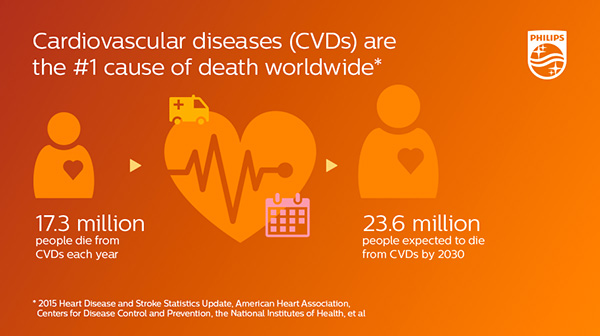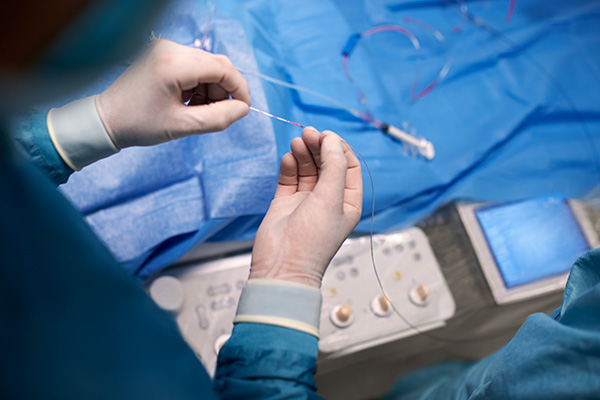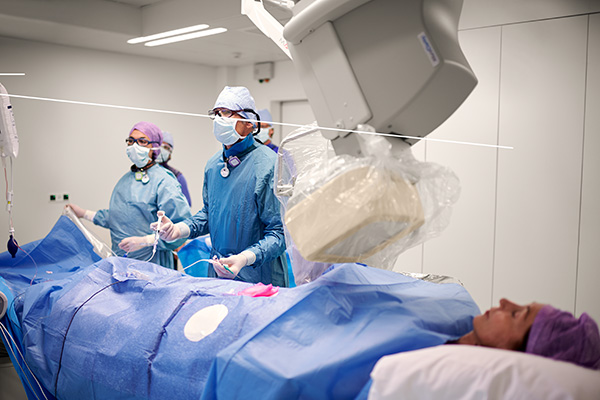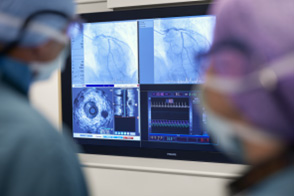An integrated approach to interventional cardiovascular medicine
According to the American Heart Association, cardiovascular diseases (CVDs) are the leading cause of death worldwide.[1] As CVDs are on the rise, it’s important to understand the risk factors associated with complex heart disease, as well as the impact of innovative solutions that can offer the best clinical benefit for both prevention and treatment.

In recent years, we’ve seen major progress in the shift from invasive and costly procedures to enhanced workflow and more integrated approaches to the diagnosis and treatment of heart disease. A combination of new innovations in image guided procedures and high-precision imaging technology has provided clinicians with increased confidence to deliver exceptional patient outcomes, enabling faster recoveries, improved patient care, and ultimately reduced healthcare costs.
Leading professional societies in the field of cardiology have recommended percutaneous coronary intervention (PCI), a minimally invasive procedure using real time image guidance, for treatment of coronary artery disease. According to the National Institute for Cardiovascular Outcomes Research (NICOR), in recent years, the number of PCI procedures has increased significantly, with worldwide research showing it to be more efficacious and cost effective than drug treatment.[2] However, the procedure itself does have limitations, with multiple factors used to determine whether a patient is suitable. For example, X-ray image guidance, though a mainstay for imaging is often limited to two-dimensional images. This is challenging because a full view of the artery is needed to confirm the extent of the blockage.


Integrated approach for innovative solutions
"Primum non nocere" or "first do no harm" has long been a principal tenet of medical training. Knowing when not to treat is just as important as knowing when treatment is required.
When it comes to definitive diagnosis and ultimately treatment, the best approach is an integrated approach. This takes into consideration the level of risk for PCI over invasive surgery and uses precision diagnostic tools that provide clinicians with a holistic view of the entire patient’s condition. We aim to provide interventional cardiologists with integrated solutions that not only allow real-time image guidance, but also a precise and detailed “roadmap” of the vessels of the heart, which can be closely monitored throughout the entire PCI procedure.Watch a recent session on complex PCI approaches to learn more.
Fractional flow reserve (FFR)* has been a revolution in helping physicians decide when to treat coronary lesions. Some can appear significant on angiogram when they are truly non–flow limiting and we have seen a positive trend over the last decade to transition from only angiographic-guided treatment to one with support of physiologic-guided treatment. FFR is a tool that gives the ability of true physiological assessment of the coronary vessel. The landmark DEFER study has now shown with 15 years of robust patient follow up, that by using FFR to help decide when not to perform PCI in single vessel disease, we can actually lower a patient's risk of myocardial infarction. In other words, “primum non nocere.”
Despite strong outcome data, FFR is still underutilized, partially because of workflow challenges related to physicians having to inject vasodilators like adenosine to induce hyperemia. Instant wave-free ratio (iFR)** is a novel technology that now improves the FFR workflow by eliminating this additional step, and also the cost of the FFR vasodilator. These technologies are a win-win as they help physicians not only treat patients, but also help our society realize cost benefits, by reducing unnecessary treatments and hospital readmissions.
Philips has integrated this approach with its intravascular ultrasound (IVUS)*** guidance. By meaningfully co-registering the IVUS and angio images together, this can help reduce the risk of not completely treating a lesion with a single stent – so called "geographic miss", which study data suggests may occur in 66.5% of PCIs. Of course having to place a second stent adds not just complexity to the case, but also cost.[3] If FFR/iFR indicates stenting is warranted, Intravascular imaging technology confirms if the stent has been placed appropriately or needs a "touch-up".

Through integrated approaches, we are increasing possibilities for patients to undergo minimally invasive PCI treatment, offering the possibility for quicker patient recovery time and fewer complications in comparison to invasive surgery. These technologies give confidence to make clinical decisions that help save costs often associated with complex procedures and invasive bypass surgeries.
Coronary artery disease and PCI is just one facet of CVD. Philips offers innovative and integrated solutions for structural heart disease and cardiac electrophysiology, keeping true to our vision of improving clinical excellence by helping physicians decide, guide and confirm the right therapy for each patient at the point of care.
*With FFR clinicians can accurately assess blood flow reserve in the coronary artery. Through a high-tech, miniaturized pressure sensor mounted on a guidewire that is inserted into the coronary artery, it is possible to identify where blood flow is reduced and ultimately determine the artery location to guide treatment strategy for the PCI procedure.
**iFR technology acts in a similar manner to FFR – but instead measures blood flow without needing a second measurement in hyperemia induced by an accompanying drug.
***IVUS is a catheter based system that provides a precise anatomical perspective from inside the coronary artery, with a 360° view and detailed look at the nature of plaques that build up on the artery wall that can lead to vessel blockage.
Bert van MeursCEO Image Guided Therapy, PhilipsBert van Meurs is CEO for the Business Group Image Guided Therapy at Philips. Bert began his career at Philips Healthcare in 1985, where he progressed through various leadership positions in R&D, Clinical Science, Marketing and Sales |
References:
[1] 2015 Heart Disease and Stroke Statistics Update, American Heart Association, Centers for Disease Control and Prevention, the National Institutes of Health, et al.
[2] National Audit of Percutaneous Coronary Interventions. Annual Public Report. January 2013 – December 2013. National Institute for Cardiovascular Outcomes Research (NICOR).
[3] Costa et al. Impact of Stent Deployment Procedural Factors on Long-term Effectiveness and Safety of Sirolimus-Eluting Stents (Final results of the Multicenter Prospective STLLR Trial). Am J Cardiol 2008 Jun 15; 101(12):1704-11.


